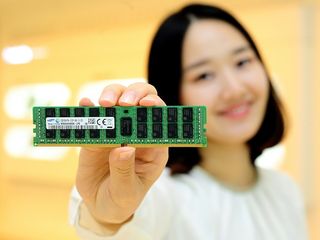Samsung's 20 nm 8 Gb DDR4 Server Memory Enters Mass Production
20nm DDR4 memory is on its way, courtesy of Samsung.

When DDR4 was announced, there were three key points that it was meant to address: higher memory densities resulting in higher-capacity DIMMs, lower power consumption, and improved performance.
At first, though, not all DDR4 memory managed to achieve all three points, but it seems that Samsung has now managed to do so. The company announced that it is now mass-producing 8 Gb DDR4 memory based on its 20 nm manufacturing process. Samsung already started production of 32 GB modules earlier this month, and they run at 2400 MHz, as opposed to the 1866 MHz frequency of the company's DDR3 server memory modules.
"Our new 20 nm 8 Gb DDR4 DRAM more than meets the high performance, high density and energy efficiency needs that are driving the proliferation of next-generation enterprise servers," said Jeeho Baek, Vice President of Memory Marketing at Samsung Electronics. "By expanding the production of our 20 nm DRAM line-ups, we will provide premium, high-density DRAM products, while handling increasing demand from customers in the global premium enterprise market."
The new 8 Gb DDR4 memory chips will also allow for up to 128 GB per DDR4 module by using 3D through silicon technology, which will make some very high-capacity memory configurations possible. (Think terabyte territory.) Such amounts of memory might not be interesting to consumers, but in the enterprise environment, having a lavish amount of memory for a server to play with can be very valuable. The DDR4 memory modules run at 1.2 V, which is the upper limit of the DDR4 reference specifications.
On the DDR3 front, Samsung also started production of 4 Gb per chip DDR3 at 20 nm, as well as 6 Gb for LPDDR3 for mobile devices.
Follow Niels Broekhuijsen @NBroekhuijsen. Follow us @tomshardware, on Facebook and on Google+.
Stay on the Cutting Edge
Join the experts who read Tom's Hardware for the inside track on enthusiast PC tech news — and have for over 25 years. We'll send breaking news and in-depth reviews of CPUs, GPUs, AI, maker hardware and more straight to your inbox.
Niels Broekhuijsen is a Contributing Writer for Tom's Hardware US. He reviews cases, water cooling and pc builds.
-
dovah-chan Does this confirm the return of the greens? O__O I thought I'd never see the day...Reply -
bit_user Server memory has generally continued to use green PCBs. Rest assured that so long as there are desktops with upgradable DIMMs, the trend of using flashy colors and gaudy heatsinks will continue.Reply
-
bit_user I think high densities are the most interesting benefit. In that sense, performance just needs to scale with density. Actually, if DDR4 is going to top out at a mere 3200 MHz, then it won't even accomplish that.Reply
The big memory performance gains on the horizon are going to come from stacking technologies like AMD/Hynix' HBM and Micron's HMC (which Intel is allegedly using in Knight's Landing, but Nvidia has supposedly abandoned).
It's interesting to contemplate the implications of these developments on computer architecture. Perhaps we'll see off-chip memory becoming relegated to server applications, where big disk caches and huge in-memory datastructures are required.
-
XM Keeper Why does every new samsung product always have a picture of it being held by korean girl?Reply -
unray by *the greens*, dovah-chan was probably referring to thoseReply
http://www.techpowerup.com/reviews/Samsung/MV-3V4G3/ -
agnickolov Hmm, something does not add (or rather multiply) up here... How do you make a 128GB module out of 8Gbit chips? You'd need 128 chips on a single module to achieve that. Even a 32GB module would need 32x 8Gbit chips and I thought a module is limited to 16-18 chips. 3D lithography does not increase the number of chips that can fit into a module, it increases the potential capacity of a single chip. I imagine what the author intended to convey is that 3D lithography would allow for up to 64Gbit chips to be developed with the same 20nm process. 16x 64Gbit chips equals one 128GB module.Reply -
serendipiti Probably some confusion wtih Gb and GB:Reply
" The company announced that it is now mass-producing 8 Gb DDR4 memory based on its 20 nm manufacturing process. Samsung already started production of 32 GB modules earlier this month, "
it seems that Gb and GB are reversed: 8GB (64Gb) - 32Gb (4GB)
-
kenjitamura What is that girl doing?! Don't let your greasy thumb rest on the golden pins like that!Reply
Most Popular




